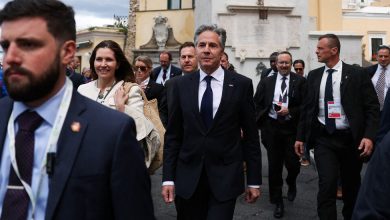The letter ‘Z’ has become a symbol for Russians who support the invasion of Ukraine.

The “Z” first drew attention several weeks ago when it was painted a couple feet high on the sides of the thousands of tanks, armored personnel carriers and other military vehicles mustering along the Russian border with Ukraine.
In Russia, the letter then began to pop up all over the place. There are Z stickers on the backs of cars and commercial vehicles, and one talk show pundit recently appeared wearing a T-shirt with a large white Z on it.
Some corporate logos and newspaper names that contained a Z manipulated the letter to highlight it. An advertising campaign using billboards in large cities featured a large Z created out of a black and orange ribbon, the St. George ribbon, which is a symbol of the Russian military.
It is not uncommon for vehicles dedicated to a military campaign to display a readily identifiable mark — U.S. Army vehicles used to repulse the Iraqi invasion of Kuwait were painted with a big white chevron, for example. To see it spread among civilians is another matter.
The campaign’s ubiquity led many to conclude that it was an orchestrated Kremlin effort to drum up support for the war, not least because it resembled so many previous efforts. It came with a hashtag with echoes of past wars: “We don’t abandon our own.” (As in soldiers.)
“This is definitely a state-induced meme,” said Vasily Gatov, a Russian-American media analyst based in Boston. “There are always people receptive to this kind of message.” He noted that there was a small army of propagandists paid to spread the meme on social media to give it the false appearance of popularity.
The fact that some of the usual suspects lined up added to the sense of government coordination.
Maria Butina was deported from the United States in 2019 after being sent to prison for working as an unregistered agent for Russia. Now a member of the State Duma, or Parliament, she posted a video of herself drawing a white Z on the lapel of her suit jacket.
“Do your work, brothers,” she said in an apparent reference to the Russian troops in Ukraine. “We will always support you.”
The state-run RT television network also spread the symbol.
Another video online showed what looked like a youth flash mob in a factory or meeting hall, wearing black T-shirts with a Z and dancing in formation amid a sea of Russian flags. Similar videos have cropped up during previous Kremlin campaigns, the only difference being the addition of the T-shirts.
Critics on social media did not miss the opportunity to point out that Hitler mobilized thousands of black-shirted supporters, as well, and some manipulated the letter Z to make it resemble the Nazi swastika.
Russia-Ukraine War: Key Things to Know
Civilians caught in attacks. As Russia steps up increasingly indiscriminate assaults on civilian targets and infrastructure in Ukraine, fears are growing that thousands of Ukrainians could die in the coming days if relief does not arrive and humanitarian cease-fires fail to take hold.
A renewed Russian assault. President Volodymyr Zelensky warned Ukraine to expect a renewed bombardment of major cities after Russian forces were stalled by stiff resistance. The warning comes as the Ukrainians and Russians were expected to meet for a third round of talks.
Russian energy imports. A bipartisan group of U.S. lawmakers reached an agreement on legislation that, if passed, would bar imports of Russian energy and suspend normal trade relations with Russia and Belarus. A jump in energy prices appears to have been stoked by this emerging effort.
No doubt some of the displays reflected genuine support. On Saturday, for example, the Russian gymnast Ivan Kuliak wore a Z on his uniform at a competition in Qatar that also included Ukrainian gymnasts. The Russian head coach and some fellow Russian gymnasts publicly defended him, even as the sport’s international governing body opened a disciplinary proceeding.
The symbol has also been deployed as a threat: Anton Dolin, a prominent film critic who left Russia over his opposition to the war, posted a picture on Facebook of a giant white Z that someone had spray-painted on his apartment door, which he called an effort at intimidation.
Oddly for a nationalist symbol, the Z being used is the version from the Latin alphabet. The Russian version, from the Cyrillic alphabet, is more rounded, like a 3.
After weeks of speculation about what it meant, the Russian Defense Ministry said on Sunday that it came from the preposition “Za,” the first word in the Russian phrase “Za pobedu,” or “For victory.”




